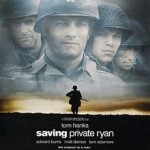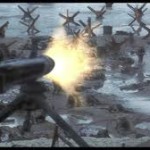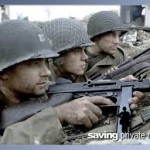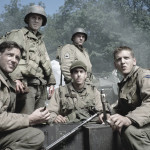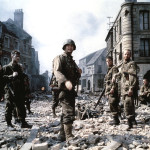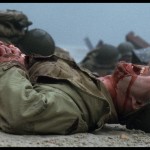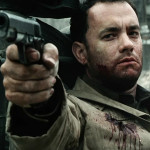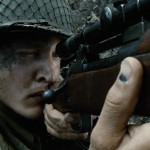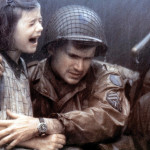My son Adam may well have a point in saying Saving Private Ryan is based on a false premise: no matter how many boys from one family had been lost, the US Chief of Staff would not in real life have sent a crack team of his finest soldiers to rescue the last living sibling, and in the process to have sacrificed almost all of them. However, Adam did love the movie, and rightly so.
Not untypical for Spielberg, this is two movies in one. Like Schindler’s List there is a depiction in some detail of factual events within the war (a favourite Spielberg topic), against which is woven a tale. In the case of SPR the sentimental story is pure fiction, but in the context of the most accurate warts-and-all depiction of war ever to hit the big screen, and the pathos of a dying Capt. John H Miller telling Private James Francis Miller “earn it,” I defy anybody not to be in floods of tears, internal or external; the fact that the drama would not have happened in real life ceases to be relevant.
Perhaps not surprising but I’d say that in hindsight these two will be viewed far and away the most important movies in the Spielberg oeuvre. Make no mistake, this is a formidably powerful film, though you would be wrong to think of it as the anti-war film it could have been. Interesting then that IMDb’s list of 100 greatest war films puts Schindler’s List top of the list, Saving Private Ryan second and Spielberg’s War Horse 8th.
Given that there is an ending with a touch of Hollywood tear-jerking, you might be forgiven for thinking this is yet another example of history being rewritten, but not so. After a brief introduction as the ageing James F Ryan visits a war cemetery in France, we are plunged straight into the horrors of D-Day, and the heavily fortified section of Omaha Beach in particular, a place where many American servicemen landed against impossible odds, and where a high proportion lost their lives. The self-sacrifice and needless loss does not bear thinking about.
And I mean you are right there in the thick of the action. The grainy camerawork captures every moment of grief in detailed close-up, colours muted but the terror of struggling from the virgin troops picked off before they had even set foot from the landing craft, into the water as the soldiers struggled to get above water, and even then the bullets fly as they headed for the beach. You too are fighting to get on the beach and establish a bridge head, to see where the German snipers and machine gun posts are located. You are taking part.
The sequence is viscerating, as well as being a technical tour-de-force. Injuries portrayed are terrible and perfectly credible: limbs and guts fly. As with a good proportion of Hollywood war epics, no actor escapes with impossibly clean uniforms, white teeth and nary a hair out of place, for which small mercy we should be grateful. That any soldiers survived at all, let alone made it beyond the bluff, is miraculous.
Neither do all the troops stand square-jawed and courageous. Here, the full spectrum of fear and reaction to shock are explored. Even the excellent Tom Hanks‘s hero, Captain Miller, is subject to shell-shock and an ongoing trembling of the hand – true heroes are not immune to the terrors, though, just as Miller does, they have the presence of mind to overcome such moments, regain composure and issue orders. That he does so almost defies logic, yet you know in reality that is exactly what happened – the beach head was eventually captured.
After this half hour tour of hell, we enter a moody, reflective period. There are a fair number of these in the course of the 2 hours 47 minutes comprising Saving Private Ryan, interspersed with moments of action and culminating in a battle scene to protect a key bridge from German troops and tanks, against huge odds and ultimately only successful through the late, late arrival of air squadrons to blow the bridge into a million fragments, but too late to save the mortally wounded Miller.
Some might argue that while light and shade are desirable, perhaps Spielberg could have shortened this by a good 20 minutes. The plot is, after all, uncomplicated, and these quiet conversations serve largely to explore the attitudes of individual troopers to the position in which they find themselves; how they want to make their way back to the farmstead back in hometown, America; how they react to their friends and brothers being killed, often to no end. Perhaps over-stressing the point?
The other side of the argument is that Spielberg is developing the characters of the team, the “band of brothers” – a phrase used by Corporal Timothy E Upham (Jeremy Davies), a cartographer struggling to come to terms with the demands of being a soldier, and later the name of a much-feted TV mini-series. Credit to the director, he has assembled a fine cast to play out the tough but fearful band, some of whom lose faith in Miller’s mission and his leadership.
Among those to look out for are Tom Sizemore, Vin Diesel, Edward Burns, Giovanni Ribisi, Adam Goldberg, Barry Pepper, and, as the eponymous Private Ryan, the ubiquitous Matt Damon. Not a single duff performance to be seen among these or any other actors on show – all ring true, without a note of false bravado. This movie was perhaps a watershed in the accurate portrayal of war, and indeed for introducing authentic notes of ambiguity where previously it had been single-minded black-and-white good versus evil, sometimes nauseatingly so.
Maybe it’s only my point of view, but in some ways it would be better for Spielberg to stop there, retire while he’s ahead, and not try to reprise these moments of genius, for his reputation then can only be diluted. Never again will he hit such heights, though such fripperies never stopped the likes of Woody Allen from working hard. In Allen’s case, his recent Blue Jasmine has been universally feted, demonstrating that he is not a spent force, though when you make epics the risk factor is that much higher. I wish Mr Spielberg well, and thank him for a handful of truly great movies, of which SPR is unquestionably one.


